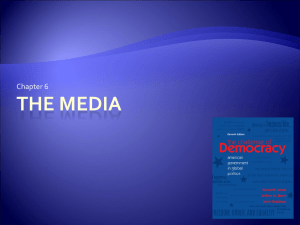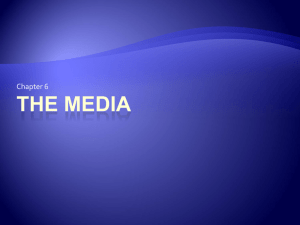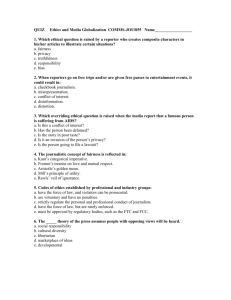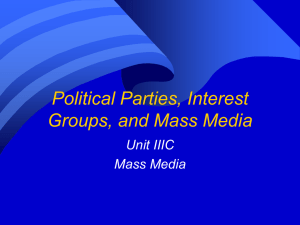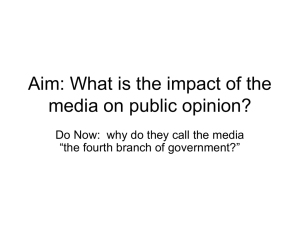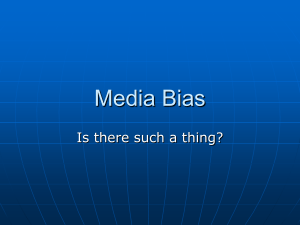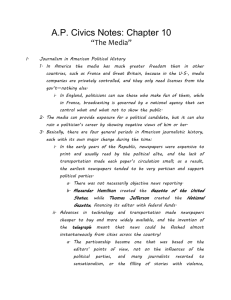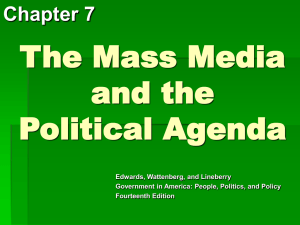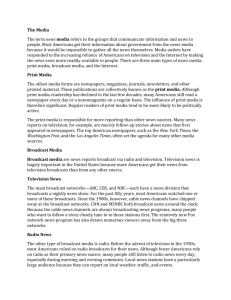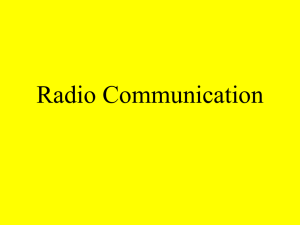Mass media - St. Pius X High School
advertisement
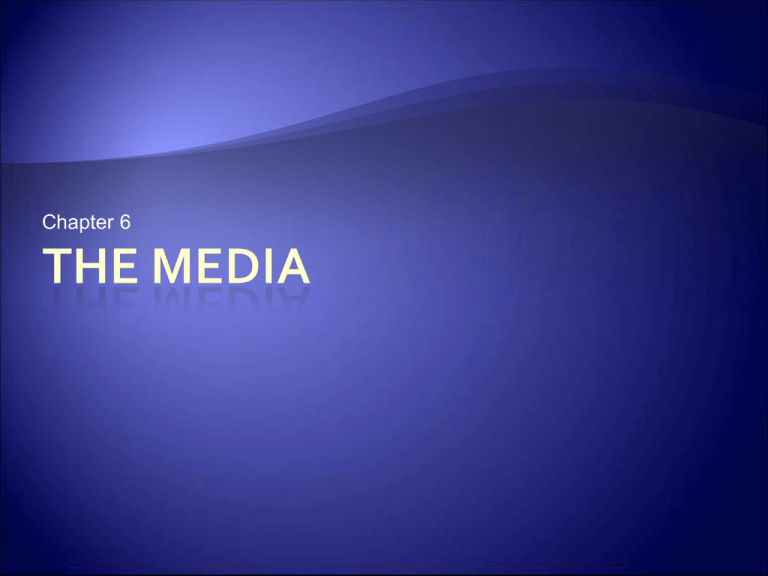
Chapter 6 The Future of the Media The printed daily newspaper as we know it in decline More and more people access news and information via the Internet Important questions: Is democratic accountability threatened by the loss of newspapers? Is web-based journalism democratizing? People, Government, and Communications Mass communication transmits information to large audiences Mass media do the communicating Print media Broadcast media Media has important role Information from government to citizens Information from citizens to government The Development of Mass Media in the United States Print and broadcast media primary means to convey political messages Newspapers Radio Television Internet And sometimes, music and film Newspapers First U.S. newspapers not really mass media Number of newspapers published has declined over time Most cities and towns have only one traditional daily newspaper Figure 6.2 Audiences of Selected Media Sources Magazines More specialized news than daily newspapers Can influence attentive policy elites Two-step flow of information then influences mass opinion However, declined circulation also has Radio Regular radio broadcasting began as local broadcasts in 1920 Coast-to-coast broadcasts first heard in 1937 More than 13,000 licensed stations today Audiences continue to grow News and talk radio popular Television First major broadcasts in 1940; color and coast-to-coast broadcasts in 1951 In 2009, U.S. had over 1,300 commercial and 300 public television stations Around 99 percent of homes have TV TV has biggest news audience after Television The Internet Began in 1969 as connection between four universities (ARPANET) Later networks linked in 1983, creating Internet Used mainly for e-mail among researchers World Wide Web (WWW) created in 1991 by European physicists Over 70 percent of Americans use Internet The Internet Majority of government agencies and political organizations have websites Private citizens operate websites and blogs on politics and public affairs Rapid way to transmit information and mobilize public opinion Major stories starting to originate on blogs; many authors consider selves journalists Compared With What? Private Ownership of the Media In U.S., private ownership of media taken for granted China has Internet police to prevent “subversive content” In some countries, print media privately owned but broadcast media run by government U.S. has about 300 public TV stations and 400 public radio stations The Consequences of Private Ownership Private media ownership means more political freedom, but also dependence on advertising revenues When looking at overall coverage, media functions more for entertainment than news Criteria for newsworthiness is audience appeal Figure 6.3 Getting the News: Consider the Source Market-Driven Journalism Larger audiences earn higher advertising rates Outside agency determines market share of shows for broadcast media So, news broadcasts and commercials are targeted for viewing audiences, both national and local Major news organizations like CBS, ABC, and NBC are part of larger corporations Must make a profit The Concentration of Private Ownership Media owners increase profit by increasing audiences or purchasing other publications or stations Rupert Murdoch’s News Corporation owns Fox, the Wall Street Journal, and MySpace Some analysts concerned about control of news by only a few owners Propose non-profit newspapers Government Regulation of Media Although privately owned, mass media regulated by government Different then State Sponsored Media Broadcast media more regulated than print media Technical regulations Ownership regulations Content regulations Technical and Ownership Regulations Federal Radio Act (1927) first licensed radio stations to impose order on frequency allocation process Federal Communications Act of 1934 established Federal Communications Commission (FCC) An independent regulatory commission Today regulates radio, TV, telephone, telegraph, cable, and satellite Telecommunications Act of 1996 eliminated many rules and regulations Telecommunications Act of 1996 Deregulated Media in the US Concentration of media into Media Conglomerates Viacom, News Corp, Time Warner, Viacom, General Electric (NBC-Universal) & Disney TV market ownership up to 35% NBC, CBS, ABC & Fox No limit on radio market ownership Clear Channel Independent Media has difficult time competing 21 Regulation of Content The First Amendment prohibits Congress from abridging freedom of the press Federal courts have decided many cases defining how far freedom of the press extends in various areas Most news allowed, except for strategic information during wartime FCC initially designed to ensure radio and TV served the public interest Fairness doctrine and equal opportunity rule Regulation of Content Fairness doctrine repealed in 1987 U.S. Court of Appeals struck down rules regulating political endorsements and personal attacks in broadcast media Print media not subject to restrictions Some advocate deregulation of broadcast media Functions of the Mass Media for the Political System Reporting the news Interpreting the news Influencing citizens’ opinions Setting the agenda for government action Socializing citizens about politics Reporting the News News media reports on important political events with journalists on location Washington, D.C. has largest press corps Media relationships with president controlled by the Office of the Press Secretary Opportunities include news conferences, press releases, “background information,” “off the record” comments, and “photo opportunities” Reporting on Congress Must be accredited to sit in press galleries Most news comes from press releases and congressional reports Sometimes have “leaks” of information Live coverage of Congress and its committees not common until House allowed broadcasts in 1979 Senate broadcasts started in 1986 C-SPAN feeds to 90 percent of cable systems across the country Interpreting and Presenting the News Media executives, news editors, and reporters function as gatekeepers of news flow and validity Personification makes news more understandable Rise of Internet has made more views available More information available, but no gatekeepers to check validity of content Media Coverage of Elections Personification of political news encourages horse race journalism Most Americans want more coverage of issues Changing poll numbers and “media events” considered more newsworthy Where the Public Gets Its News Newspaper most important source until 1960s, then TV Today, 65 percent of Americans name TV or cable news networks as primary news source Newspapers 14 percent Internet 11 percent Multiple sources used by many, including late-night talk shows What People Remember and Know Although 80 percent of public access news media each day, most retain little National survey in 2009 found respondents could only answer five of 12 questions about current events correctly Those who rely on TV retain less than those who read print media Some media researchers believe TV is behind low level of citizen knowledge about public affairs Television Hypothesis Figure 6.5 Gagging on Late-Night TV Influencing Public Opinion Difficult to measure extent of media’s influence on public opinion Does the media create public opinion by its reporting of events? Studies on specific areas, such as pretrial coverage of serious criminal cases, show significant influence Setting the Political Agenda Most scholars see media’s greatest influence in its ability to identify issues needing government attention Media can force government to address unpopular or unknown issues Some issues, such as crime, disproportionately covered Public also influences media coverage Setting the Political Agenda Politicians eager to influence media coverage Public opinion Opinions of attentive elites Presidents sometimes “go public” to advance a political agenda Setting the Political Agenda 37 Socializing the Citizenry Young people politically socialized via media’s entertainment function Media reinforces dominance of existing culture and order Today, messages about government very different than in past Media has contradictory roles in process of political socialization Evaluating the Media in Government Some believe news filtered through ideologies of media owners, editors, and reporters Reporters tend to be liberal (32%) rather than conservative (8%) Editors and owners more conservative - control content Talk radio dominated by conservatives Figure 6.6 Partisanship and the Credibility of the News Evaluating the Media in Government In general, incumbents receive more news coverage than challengers Political bias in coverage depends on the party in power Media may also be biased in the way news stories reported Contributions to Democracy Most political communications from government to citizens through media News reporters tend to be critical of politicians, serving watchdog function Media polls enable reporting of public opinion on major issues Necessary for majoritarian model of government Effects on Freedom, Order, and Equality Media has played important role in advancing equality Media coverage of civil rights movement critical to its success However, media resists government efforts to use it to promote public order What is balance between free press and national security? 43
